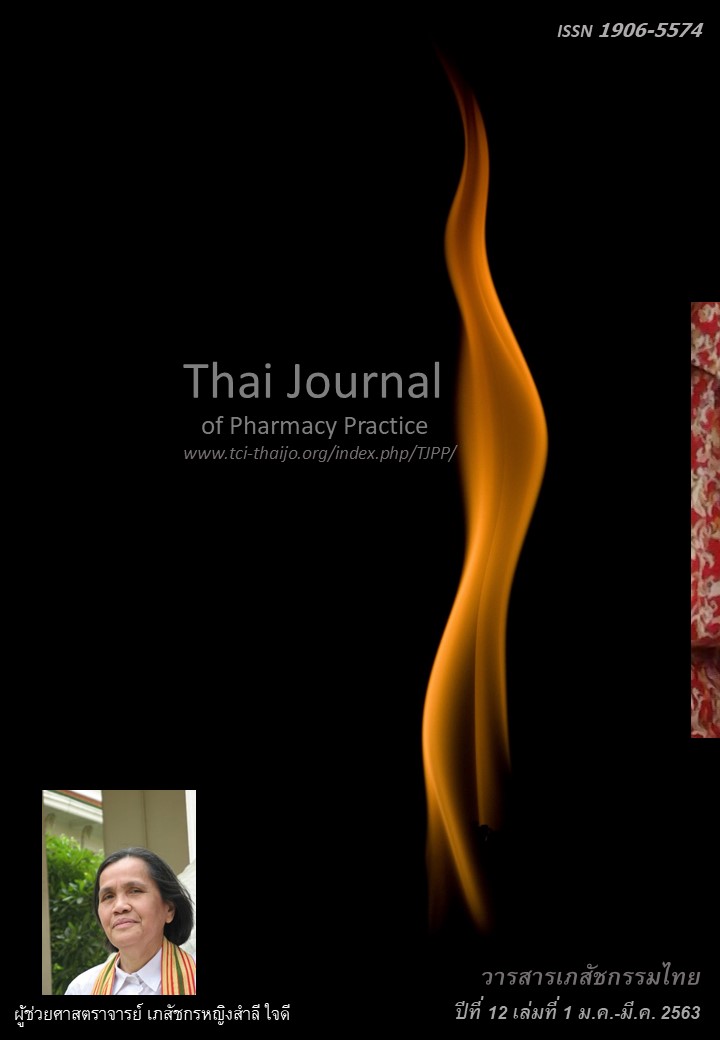ผลของการแทรกแซงหลายรูปแบบต่อการสั่งใช้ยาปฏิชีวนะในโรคคอหอยอักเสบและ ท้องร่วงเฉียบพลันในหน่วยบริการสุขภาพปฐมภูมิ อำเภอปากพะยูน จังหวัดพัทลุง
Main Article Content
บทคัดย่อ
วัตถุประสงค์: เพื่อศึกษาผลของการแทรกแซงที่ประกอบด้วยการอบรมให้ความรู้เรื่องการใช้ยาปฏิชีวนะอย่างสมเหตุผลในโรคคอหอยอักเสบ (acute pharyngitis: AP) และโรคท้องร่วงเฉียบพลัน (acute gastroenteritis: AGE) การแจกสื่อความรู้/อุปกรณ์ช่วยวินิจฉัยโรค และการนิเทศติดตามต่อการสั่งใช้ยาปฏิชีวนะอย่างสมเหตุผลในสองโรคดังกล่าวในบุคลากรทางการแพทย์ของโรงพยาบาลส่งเสริมสุขภาพตำบล (รพ.สต.) ในเขตอำเภอปากพะยูน จังหวัดพัทลุง วิธีการ: ผู้สั่งใช้ยาใน รพ.สต. 18 แห่งในอำเภอปากพะยูน จังหวัดพัทลุง ถูกสุ่มแยกโดยการจับฉลากเป็น 2 กลุ่ม คือ กลุ่มควบคุม (9 รพ.สต.) และกลุ่มทดลอง (9 รพ.สต.) ทั้งสองกลุ่มได้รับการอบรมให้ความรู้เรื่องการใช้ยาปฏิชีวนะอย่างสมเหตุผลในโรค AP และ AGE ได้รับสื่อความรู้ และได้รับอุปกรณ์ช่วยวินิจฉัยโรค กลุ่มทดลองได้รับการนิเทศในเดือนที่ 2 และ 4 หลังการอบรม กลุ่มควบคุมได้รับการนิเทศในเดือนที่ 4 เพียงครั้งเดียว การศึกษารวบรวมข้อมูลการสั่งใช้ยาในสองโรคเป้าหมายด้วยโปรแกรม E-tool version 4.0 ก่อนและหลังการแทรกแซงทุกเดือนเป็นเวลา 6 เดือน ผลการศึกษา: หลังการอบรมให้ความรู้ ทั้งกลุ่มควบคุมและกลุ่มทดลองมั่นใจมากขึ้นว่า ตนสามารถไม่ใช้ยาปฏิชีวนะในโรค AP (P=0.027 และ 0.027 ตามลำดับ) และโรค AGE (P=0.039 และ 0.042 ตามลำดับ) หลังการอบรม 2 เดือน ทั้งสองกลุ่มมีอัตราการใช้ยาปฏิชีวนะในโรค AP และ AGE ลดลงร้อยละ 9-10 และ 11-12 ตามลำดับ เมื่อมีการนิเทศในกลุ่มทดลองหลังการอบรมผ่านไป 2 เดือน พบว่า ในเดือนที่ 4 หลังการอบรม อัตราการใช้ยาปฏิชีวนะในโรค AP และ AGE ของกลุ่มทดลองน้อยกว่ากลุ่มควบคุมร้อยละ 6 และ 8 ตามลำดับ (P=0.001 และ 0.001) การนิเทศกลุ่มควบคุมในเดือนที่ 4 หลังจากการอบรมสามารถลดอัตราการใช้ยาปฏิชีวนะในโรค AP และ AGE ได้ประมาณร้อยละ 5 และ 6 ตามลำดับ กลุ่มทดลองที่ผ่านการนิเทศสองครั้ง มีอัตราการใช้ยาปฏิชีวนะน้อยกว่ากลุ่มควบคุมที่ผ่านการนิเทศเพียงครั้งเดียวประมาณร้อยละ 3-4 ในโรค AP ในเดือนที่ 6 หลังการอบรม (P=0.010) แต่ไม่พบความแตกต่างของการนิเทศสองครั้งและครั้งเดียวในโรค AGE สรุป: การแทรกแซงโดยการอบรมให้ความรู้ สื่อความรู้ และอุปกรณ์ช่วยวินิจฉัยโรคเพิ่มความมั่นใจของบุคคลากรใน รพ.สต. ในการไม่ใช้ยาปฏิชีวนะในโรค AP และ AGE การอบรมให้ความรู้ร่วมกับการแทรกแซงโดยการนิเทศติดตาม ทำให้การสั่งใช้ยาปฏิชีวนะลดลง โดยพบว่าการนิเทศติดตามจำนวน 2 ครั้งในโรค AP ทำให้การสั่งใช้ยาปฏิชีวนะลดลงชัดเจนกว่าการนิเทศ 1 ครั้ง แต่ในโรค AGE พบว่าจำนวนของการนิเทศติดตามไม่มีผลต่อการสั่งใช้ยาปฏิชีวนะที่ลดลง
Article Details
ผลการวิจัยและความคิดเห็นที่ปรากฏในบทความถือเป็นความคิดเห็นและอยู่ในความรับผิดชอบของผู้นิพนธ์ มิใช่ความเห็นหรือความรับผิดชอบของกองบรรณาธิการ หรือคณะเภสัชศาสตร์ มหาวิทยาลัยสงขลานครินทร์ ทั้งนี้ไม่รวมความผิดพลาดอันเกิดจากการพิมพ์ บทความที่ได้รับการเผยแพร่โดยวารสารเภสัชกรรมไทยถือเป็นสิทธิ์ของวารสารฯ
เอกสารอ้างอิง
2. Rajesh RU, Gurdeep SK, Vijay MK, Onkar CS. Resistance: a sensitive issue, European roadmap to combat antimicrobial resistance. J Clin Diagn Res 2014; 8: 1–4.
3. United States Agency for Healthcare Research and Quality. Reducing and preventing adverse drug events to decrease hospital costs [online]. 2005 [cited Jun 29, 2014]; Available from: archive.ahrq .gov/research/findings/factsheets/errors-safety/ader ia/ade.html
4. Wiffen GM, Edwards J, Moore A. Adverse drug reactions in hospital patients: a systematic review of the prospective and retrospective studies [online]. 2002; [cited Jun 29, 2014]; Available from: www.medicine.ox.ac.uk/ bandolier/band101/b101-4.html
5. Bureau of Drug Control, Food and Drug Adminis- tration. Value of production and import of medicines during 2000-2007 classified by pharmacological activity. Bangkok: Health Product Safety Surveil- lance Center Planning and Research; 2553: 64.
6. Jerngsathiensub K, Singoenwong L, Paoin W. Drug and community: social and cultural dimensions. Nonthaburi: Bureau of Social and Health Research; 2007.
7. Aswapokee N, Vaithayapichet S, Heller R. Pattern of antibiotic use in medical wards of a university hospital, Bangkok, Thailand. Clin Infect Dis. 1990; 12: 136-41.
8. Apisarnthanarak A, Danchaivijitr S, Khawcharoen porn T, Limsrivilai J, Warachan B, Bailey TC, et al. Effectiveness of education and an antibiotic-control program in a tertiary care hospital in Thailand. Clin Infect Dis. 2006; 42: 768-75.
9. Udomthavornsak B, Tatsanavivat P, Patjanasoontorn B, Khomthong R, Bhuripanyo K, Saengnipanthkul S, et al. Intervention of inappropriate antibiotic use at a university teaching hospital. J Med Assoc Thai 1991; 74: 729-36.
10.Health Product Vigilance Center. Summary of adverse drug reactions during 2009-2010. Bangkok : Health Product Vigilance Center Planning and Research Food and Drug Administration; 2010.
11. Health Product Vigilance Center. Drugs that require severe drug rash warnings SJS-TEN type. Bangkok : Health Product Vigilance Center Planning and Research Food and Drug Administration; 2012
12. Anuwong K, Sumpradit N, Chongtrakul P, Pumtong S, Kongsomboon K, Butdeemee P, et al. Antibiotics Smart Use in Saraburi Province 2008 J Health Sci 2008; 6: 10-6.
13. Phunphattanapree P. The effectiveness of the Antibiotic Smart Use program in patients with acute infection of upper respiratory tract, diarrhea and clean wounds in Ban Phraek Hospital. GPO Journal 2013; 20: 6-9.
14. Thamlikitkul V, Apisitwittaya W. Implementation of clinical practice guidelines for upper respiratory infection in Thailand. Int J Infect Dis 2004;8: 47-51.
15. Aswapokee N, Vaithayapichet S, Komotri C. The failure of a preprinted order form to alter physicians' antimicrobial prescribing pattern. J Med Assoc Thai 1992; 75: 223-30.
16. Ayuthya SK, Matangkasombut OP, Sirinavin S, Malathum K, Sathapatayavongs B. Utilization of restricted antibiotics in a university hospital in Thailand. Southeast Asian J Trop Med Public Health 2003; 34: 179-85.
17. Prathep Na Thalang O. Effects of multiple interventions on performance of medical supplies management among health centers at Nuea Khlong District, Krabi Province [minor thesis]. Songkhla: Prince of Songkla University, 2004.
18. Trap B, Todd CH, Moore H, Laing R. The impact of supervision on stock management and adherence to treatment guidelines. Health Policy Plan. 2001; 6:273-80.


